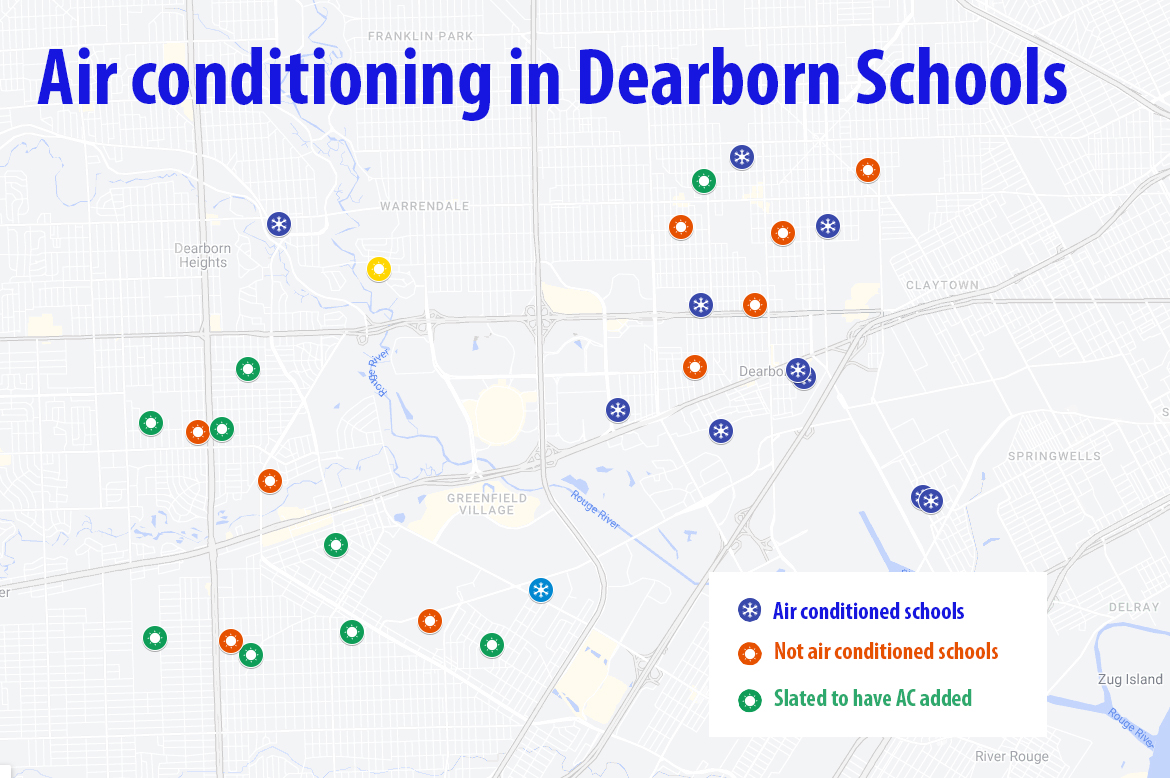This is an interesting time for those interested in Dearborn Public Schools facilities.
At the Jan. 10, 2023 Board of Education meeting, Fielding International will give an update about its work to create a long-term Future of Learning plan for Dearborn. The actual 30-year plan that will look at instructional and facility needs of the district is expected to be presented to the Board of Education in March. Before that, public town hall meetings will be held. Dates are expected to be announced in January.
Earlier this month (December 2022), the district announced it would be able to spend almost $100 million on our buildings over two years thanks mostly to ESSERs and COVID relief funding.
The largest single item on the infrastructure list – about $40 million – will be spent to improve ventilation and install air conditioning at several of our buildings.
Less than one-third of the district’s 33 school buildings are air-conditioned, so questions arose about how we selected the eight (possibly nine) elementary schools for air conditioning.
First, it’s important to understand the federal ESSERs funding cannot be spent on just any infrastructure improvements. Improved air-handling projects are an allowed expense.
In all eight of the buildings that we plan to add air-conditioning, we will also be performing some much needed boiler upgrades as part of the federally-funded project. Of the 11 calendar months a year we have students in the buildings, the heat is typically on for seven or more of them. DuVall, Howard and Lindbergh schools all had boiler replacements as part of the work that would have been done under the failed 2019 BRICS bond. Haigh was slated to have the addition with the bond that is now planned with ESSER funds, in addition to adding some air conditioning at that building.
Each of these smaller schools is expected to cost between $4 million to $6 million for the air-conditioning projects. Larger schools, like our middle or high schools would cost much, much more. For example, compare the 37,000 square feet at Nowlin Elementary to the 241,500 square feet at Edsel Ford High.
A number of factors went into selecting schools. In this case, moving to the top of the list was the need for other needed infrastructure work in the building, such as boilers and air handlers, that could also be funded and maximize our use of the restricted federal funding. Other considerations included the cost of adding air conditioning; the vulnerability of the students in the school both for age and the number of special education classes; and how much the building is used in the summer.
We’ve created a map of which schools do and do not have air-conditioning, which also lists what HVAC work will be included in the ongoing infrastructure work.
The map is also a study of the history of Dearborn.
More of our oldest buildings are on what is now the east side of Dearborn, which were the first areas settled and developed. Eleven of our schools were built during the heady days of the 1920s, eight of them on the east side of the district. (See our list of building ages and sizes.)
No current district schools were built during the 1930s as the world was gripped by the Great Depression.
Starting in the mid 1940s, west Dearborn began to grow rapidly. The baby boom meant the district added a number of schools in the west half of town during those decades. Twelve of our current schools were added during those years with Stout Middle and River Oaks Elementary, built in 1960, being the last. (At the time, River Oaks was not part of Dearborn Public Schools.)
All of this growth was before air-conditioning became the norm. All of those buildings have boilers for heat, which is more efficient than forced air. But boilers also mean there are no air-ducts to more easily add air-conditioning to an existing HVAC system.
As the baby boomers finished school, enrollment in the district declined for a few decades and schools were sold, not built. By the time enrollment started to grow again and new school construction resumed in 1992 with Becker and William Ford elementaries, air conditioning had become the standard. That new construction, or in cases like Henry Ford Elementary massive reconstruction, was focused on the east side of Dearborn where higher housing density meant a lot more students coming to the district. The newest schools in the district, built in 2005 include Geer Park, McCollough/Unis and the Michael Berry Career Center.
Other resources

